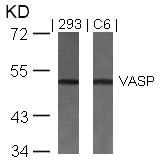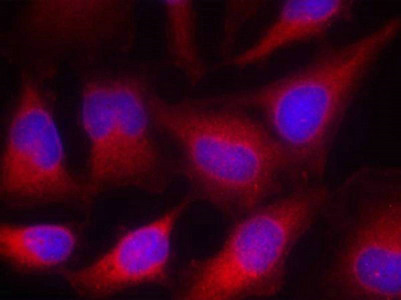
Western blot analysis of extracts from 293 and C6 cells using VASP(Ab-157) Antibody.
VASP (Ab-157) Antibody
CSB-PA158569
ApplicationsImmunoFluorescence, Western Blot, ELISA
Product group Antibodies
ReactivityHuman, Mouse
TargetVASP
Overview
- SupplierCusabio
- Product NameVASP (Ab-157) Antibody
- Delivery Days Customer20
- ApplicationsImmunoFluorescence, Western Blot, ELISA
- CertificationResearch Use Only
- ClonalityPolyclonal
- ConjugateUnconjugated
- Gene ID7408
- Target nameVASP
- Target descriptionvasodilator stimulated phosphoprotein
- Target synonymsvasodilator-stimulated phosphoprotein
- HostRabbit
- IsotypeIgG
- Protein IDP50552
- Protein NameVasodilator-stimulated phosphoprotein
- Scientific DescriptionVasodilator-stimulated phosphoprotein (VASP) is a member of the Ena-VASP protein family. Ena-VASP family members contain an EHV1 N-terminal domain that binds proteins containing E/DFPPPPXD/E motifs and targets Ena-VASP proteins to focal adhesions. In the mid-region of the protein, family members have a proline-rich domain that binds SH3 and WW domain-containing proteins. Their C-terminal EVH2 domain mediates tetramerization and binds both G and F actin. VASP is associated with filamentous actin formation and likely plays a widespread role in cell adhesion and motility. VASP may also be involved in the intracellular signaling pathways that regulate integrin-extracellular matrix interactions. VASP is regulated by the cyclic nucleotide-dependent kinases PKA and PKG. Zhao WM, et al. (2001) EMBO J 20(9): 2315-2325. Millard TH, et al. (2005) EMBO J 24(2): 240-250. K
- ReactivityHuman, Mouse
- Storage Instruction-20°C or -80°C
- UNSPSC12352203

